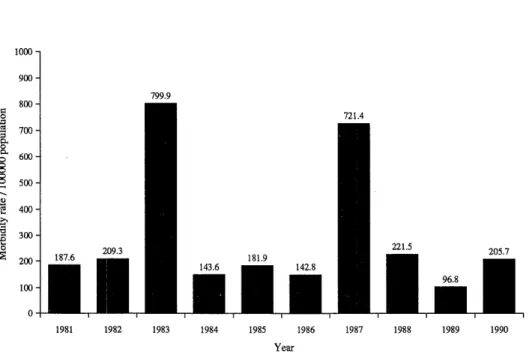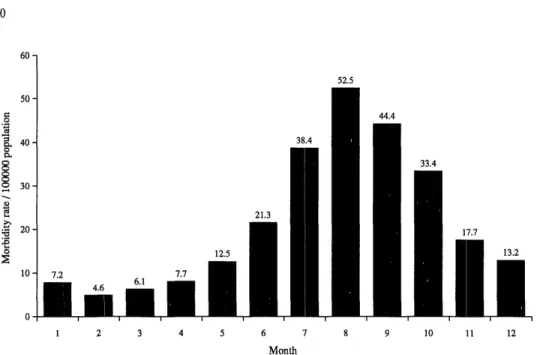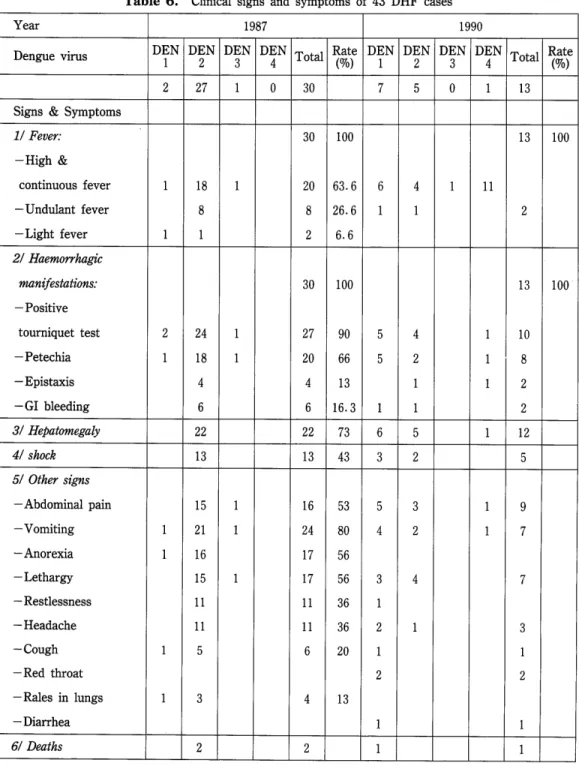Epidemiology and Clinical Features of Dengue Hemorrhagic Fever in Ho Chi Minh City and the Centre for
Tropical Diseases; Viet Nam
NGUYEN Duy Thanh, PHAM Ngoc Giao
Cent柁for Tropical Diseases (Cho Quan Hospital), Ho Chi Minh city; Viet Nam.
Abstract: Dengue haemorrhagic fever (DHF) is one of the major infectious diseases in Viet Nam. In the south of Viet Nam, DHF occurs all the year round. The number of DHF cases has been recorded as the greatest one among many countries in the world (1983:
77,087 cases and 1,301 deaths; 1987: 83,905 cases and 904 deaths). The DHF morbidity rate in children in south of Viet Nam was high (380.73/100,000 population in the 1983 epidemic and 378.37/100,000 population in the 1987 epidemic).
The mortality rate in Ho Chi Minh city (1981‑1990) is 1.05 (/100,000 population) and the mean mortality rate (/total of cases) is 0.55%. The majority of confirmed cases were children of 5‑9 years old. In the DHF with shock, hepatomegaly relates to the severe grades. In the traetment of DHF without shock, patients were given fluid to drink on the first day to prevent shock.
Key words: Dengue haemorrhagic fever, south of Viet Nam, epidemiology, clinical features, treatment
INTRODUCTION
Dengue hemorrhagic fever (DHF), an epidemic caused by mosquitoes, has spread dramatically all over countries in South‑East Asia and the Western Pacific regions. In the South of Vietnam, DHF occurs all the year round in many provinces and cities with a large number of patients. DHF epidemics usually take place from June to November. The peak transmission has been recognized in July, August and September. Major epidemics occurred
in a 3‑4 year frequency and increased from 1975 to 1990 (Table 1).
Large DHF outbreaks in South Vietnam in 1975, 1979, 1983, 1987 that occurred at the same time with severe outbreaks in the whole country, has shown the 4 year cycle of out‑
break.
DBF epidemiology i皿HCM city (1981‑ 1990):
The morbidi砂rate per 100,000 population in HCM city (1981‑1990): (Table 2 and Fig. 1) The DHF Morbidity rate/100,000 population in HCM city (1981‑1990)
‑Years having no epidemics: 96.8‑221.5, on mean 159.1
‑Years having epidemics : 1983: 799.9 1987: 721.4
Year M orbidity M ortality No. of cases Rate No. of cases Rate
l 05 population 105 population
CFR*
(%)
1975 19, 416 1979 21, 285 1983 77, 087 1987 83, 905
112. 44 397 115. 13 466 380.73 1,301 378. 37 904
2.29 2.52 6.42 4.07
4 (3O 00 t‑
(
‑ } ,
‑
<
(
」
>
<
 ̄ 1
CVJ CM .‑I T‑I
"Case fatality rate.
Table 2. Number of DHF cases in HCMC, 1981‑1990
Year No. of Morbidity Year No. of Morbidity
patients rate/ 1 0 5 patients rate/ 1 0 5 population population 1981 4, 551
1982 6, 698 1983 26, 398 1984 1, 885 1985 6, 367
187. 6 1986 209. 3 1987 799. 9 1988 143. 6 1989 181.9 1990
5,001 25, 972
8,196 221.5 3, 775
8, 227 205. 7
Referred to the statistics of Preventive Medicine Centre, MCM city
‑Mortality rate/cases : 0.23‑0.8%, on mean 0.55%
‑Mortality rate per 105 population: 1.05
The spreading of DHF epidemic:
On supervising DHF epidemics from 1981 to 1990, we see that it has developed in 12 urban districts of HCM city and thereafter spread to all 6 suburban ones (Fig. 2).
‑In urban districts, epidemics o洗en had developed highly in crowded population
‑In the suburbs, the local people had to use various kinds of containers to reserve water, so that they supply good condition for A. aeg¥ゆti to breed and develop.
Although the epidemics could spread to the suburban districts, their distribution was not equal. The lowest index of cases had been seen in districts situated far form the city
center.
The development of epidemics by months: (Fig. 3)
DHF cases were recorded all year round. Epidemics have usually occurred from June to November with lowest rate in the dry season (January‑April), increasing in May and June. Epidemics have developed dramatically in the rainy season (from July to October) with peak transmission in August and September, and decreasing slowly in November. The seasonal characteristic of DHF is obvious in HCM city.
Epidemic distribution by age and seventy: (Table 3‑1 and 3‑2)
(Based on the investigation of the 1987 outbreak in District I, HCM city)
Fig. 1. The DHF morbidity rate/100,000 population in HCMC (1981‑1990)
Fig. 2. The mean morbidity rate/100,000 population of urban districts compared with the suburban districts.
Fig. 3. The development of DHF by month (1981‑1990)
Based on above two tables, we note:
‑The most affected age groups are 5‑9 (39.5%), and 10‑14 (29.6%). Total 69.1%.
‑The morbidity rate of adults above 15 years is only 10.7%. So, DHF patients in HCM city and Southern provinces are mostly children.
‑The patients in grade IH and N are mostly children in 2 age groups: 5‑9 years (49.2%), and 10‑15 years (27.4C糾. Total 76.6%.
Table 3‑1. Distribution by age groups
Age (groups) No. of cases Rate (%) Under 4 years
5‑9 years 10‑15 years Above 15 years
406 796 595 215
20.2 39.5 29.6 10.7 Tota1 2, 012 100. 0
Table 3‑2. Distribution by severe grades (grades M, F) Age (groups) No. of cases (grades IH, N) Rate (%) Under 4 years
5‑9 years 10‑15 years Above 15 years
85 217 l21 18
19.3 49.2 27.4 4.1 Tota1 441 100. 0
DHF status at the Centre for Tropical Diseases, HCM city:
Data from 1981 to 1990: (Table 4)
‑There were 2 outbreaks at interval of 4 years (1983 and 1987)
‑The overall death rate of the year 1987 was lower than that of 1983.
‑The number of children under 15 years was 92.44%.
‑The rate of infant deaths under 10 years was 1.07%, that was higher than the overall death rate (0.99%).
Table 4. Number of hospitalized patients and deaths
rae2
Admis sion D eaths
TotalChildrenTotalOverallrate (%)childrenRate(%)
1,782 1,757 2,246 1,906 6,550 6, 123 1, 768 1, 703 1,593 1, 502 1,163 1,141 7, 324 6, 731 2,305 2,024 1,154 1.069 2, 162 1,971 28, 047 25, 927
i‑i (NI CO
( 古 0 0 0 0 O O O O O O O O O O C T 5
O^ O^ CTi O^
1 1 1 1 1 1 1 1 1 1
14 0.78 22 0. 98 1.35 16 0.90 23 1.40 18 1.54 57 0.37 21 0.90 0.77 11 0.50
14 0.79 22 1.15 1.45 16 0.93 23 1.50 18 1.57 56 0. 83 20 0. 98 1.18 10 0.50
280 0. 99 (Mean) 277 1. 07 (Mean)
The clinical signs of DHF virologicalわl confirmed ♪utients treated in Centre for Tropical Diseases during 1987 and 1990:
II Dengue virus types: (Table 5)
In the outbreaks of 1983, 1987, 1990, we sent many blood specimens to the Pasteur In‑
stitute, HCM city to isolate virus. Positive results were obtained only in 2 years 1987 and 1990.
1987: 30 cases (+)/190 blood specimens 1990: 13 cases (+)/223 blood specimens Total: 43 cases.
Especially, in 1987, Pasteur Institute (HCMC) isolated 4 Japanese encephalitis viruses in blood specimens of 4 infants (2 in HCM city, 1 in Song Be province, and 1 in Dongthap province). These 4 patients had typical clinical manifestations of DHF as:
‑ High fever
‑Headache
‑Petechia
‑Painful enlargement of the liver
These patients consisted of 3 boys (4, 6, & ll years old) and 1 girl (6 years old) The duration of disease was 6‑8 days.
Dengue virus could not be isolated in these 4 patients and they did not have any cen‑
tral nervous system manifestation.
Table 5. Dengue virus types of 43 cases
Dengue virus types 1987 (No. of cases) 1990 (No. of cases) DEN‑ 1
DEN‑2 DEN‑3 DEN‑4
2 27
1
0
7 5
0 1
Tota1 30 1 3
21 Clinical signs and symptoms of 43 DHF cases (Table 6) (Based on sero‑type)
In the 1987 & 1990 outbreaks, the majority of isolated dengue virus type were DEN‑1 and DEN‑2. However, the dominant type was DEN‑2 in the 1987 outbreak (covering 90%)
*Fatal cases:
Two cases DEN‑2 (1987) and one case DEN‑1 (1990) died as consequence of severe gastrointestinal haemorrhages, irreversible shock and late hospitahzation.
31 Hepatomegaly:
The enlargement of the liver is one of four clinical criteria to diagnose DHF (WHO).
However, it has some relationship with severity grade.
In the DHF epidemic of 1983, we have monitored the enlarged liver m 4,338 cases divided into 2 groups (with and without shock) and have noted as follows: (Table 7)
‑Hepatomegaly could be seen in both groups. However, the liver became enlarged only from the third day of illness.
‑In comparison between shock group and non‑shock group:
The incidence of hepatomegaly has been double (p<0.0001),
The size of liver has been greater,
・The soreness has been more marked and durable.
Table 6. Clinical signs and symptoms of 43 DHF cases Year 1 987 1990
Den‑e virus 苧" D誓" D苦"間Total顎DENIDEN
2DEND晋NTotalRate (%)
123
27 30 13 Signs & Symptoms
II Fever:
‑High &
continuous fever
‑ Undulant fever
‑ Light fever
l
‑
‑ o o
‑ l
1
00l
03 00ー3ー2ーーー4ー6ー666co<」>.c」><>J*‑S‑‑N
21 Haemorrhagic man ifestations:
‑ Positive tourniquet test
‑ Petechia
‑ Epistaxis
‑GI bleeding 31 Hepatomegaly 41 shock 51 Other signs
‑Abdominal pain
‑ Vomiting
‑ Anorexia
‑ Lethargy
‑ Restlessness
‑ Headache
‑ Cough
‑Red throat
‑Rales in lungs
‑ Dia汀hea 61 Deaths
1
s 1
‑
*
2 ー 00ー03 i‑ILOCSII‑H<OCO3063.33Oit」>,‑itot>‑^lt‑o‑ナ4ヤc‑JCVI^^(NIT‑H 00ー3ー ∩
2 oo c M CM 」 2 in
l 1 l l l
1 1
1 1l1ini‑i<」>LO,‑<.‑<cM,‑<,‑<t‑I‖53
ー
to C」> CO CO m o o t o m c o c o
i‑i CM i‑I ‖ 6 3ー
4
3 2 5 4
CO .‑< CJ .‑I CVl
l 1
41
9 7 ー ー
73 ー 2
l
2 2 1
Clinical signs Grade 1 , 1 Grade in, IV Disparity between 2 (3, 200) (1, 138) groups No. of Rate (%) No. of Rate (%) Chi‑ P‑values
cases cas es squares
‑Hepatomegaly 1 , 440 45 967 85 35. 16 < 0. 0001
‑Palpable, below right costal margin:
*1c皿
*2‑4cm
1, 632 51 205 17. 68 25. 76 <0. 0001 1, 568 49 933 82. 30 24. 10 <0. 0001
‑The day of the hepatomegaly s appe arance lst & 2nd 3rd 4th 5th 6th
‑ Painless hepatomegaly
‑ Painful hepatomegaly 0
424 44. 47 1,248 38.80 528 16. 63
0 0 2, 656 83. 50
480 14. 48
cDi‑<LOcoCM(」>or‑<o<NIScoc3c^a‑*‑rf‑^‑^t>‑
18.67 14.48 0.00014 35. 23 0. 34 0. 5579 37.62 11.06 0.0008 0. 0038 37. 50 44. 47 <0. 0001 62. 30 48. 90 <0.0001
Treatment:
Most of DHF has mild and moderate course. The shock cases are rare and could be saved if treated from the pre‑shock state by rapid volume replacement of fluid and elec‑
trolytes to compensate the leakage of plasma as consequence of an acute increase of vascular permeability.
In 1987, in a double‑blind randomized study on the use of oral rehydration solution m the treatment of DHF from the first day of illness, Dr. Nguyen Thi Thu Thao has concluded as follows:
I/ No case of shock has been unregistered if the patient was given fluid in the first day (whatever the kind of oral solution might be used).
2/ Fluid administered on the first day is easier because the patient rarely vomits and the amount of vomited material is a little (vomiting incidence is low, about ll%).
3/ The incidence of DHF patient became shock after the use of fluid was 15.6% (fluid given from the second day) and ll.5% (fluid given from the third day), respectively.
Note:
Patients were randomized into 3 groups (A, B, C) based on the kind of fluid used:
A: ORS‑supplied by UNICEF.
B: Solution compound of saccharose‑salt and bicarbonate. The amount of fluid is calculated based on body weight and the degree of fever.
C: Fruit juice plus plain water, used as tolerated by the body.
Conclusion :
In the past 20 years the number of DHF patients in HCM city and Southern provinces of Vietnam has continued to increase and recorded as the greatest one among other countries in the would. Severe epidemics have occurred in a 3‑4 year fiequency as in 1983, 1987, and 1990.
The rainy season is ̀̀DHF season'in South Vietnam (from June to November every year). In the 1987 outbreak the predominant type was DEN‑2, but in the 1990, the DEN‑1 was continuing to grow‑up.
In DHF with shock, hepatomegaly relates to the severe grades.
In the treatment of DHF without shock: it was easier for us to give patients fluid to drink on the first day because these patients do not like drinking, but they feel thirsty and can drink if forced. Therefore, in DHF without shock, early oral rehydration therapy can con‑
tribute to prevent shock.
Table 8. Relationship between the day of admission and the incidence of shock based on the fluid used
Kind of solution Group
A B C
Total
Admission day
lst: No. of patients 7 No. of shock cases
3 0
2nd: No. of patients 35 30 No. of shock cases 3 (8.75%) 6 (20%)
3rd: No. of patients 38
No. of shock cases 5 (13.6%) 6 (12.5%)
1
0
ll 0
12 77
3 (25%) 12 (15.6%)
27 113
2 (7.4%) 13 (ll.5%)
1) Do Quang Ha βt al. (1992): DHF/DSS epidemic in South Vietnam during 1975‑1990 and the
strategy of its control. J. Trop. Infect. Diseases, Publ. Health Assoc.: HCMC 4: 27‑32 (in Viet‑
namese).
2) Do Quang Ha βt al. (1993): DHF/DSS epidemic in South Vietnam during 1975‑1990 and the
strategy of its control. J. Trop. Infect. Diseases, Publ. Health Assoc.: HCMC 12: 42‑49 (in Viet‑
namese).
3) Gubler, D. J. (1987): Current research on Dengue, pp 37‑56. In Current Topic in Vector Research.
Vol. 3, edited by Kerry F. Harris, Springer‑Verlag, New York.
4) Igarashi A. (1978): Isolation of Singh's Aedes albopictus cell clone sensitive to dengue and Chikungunya viruses. J. Gen. Virol, 40: 531‑544.
5) Jay P. Sanford (1987): Japanese Encephalitis. In Harrison s Principle of Internal Medicine.
6) Nguyen Buy Thanh (1991): Infectious and Communicable Diseases (in Vietnamese).
7) Nguyen Buy Thanh (1982): Epidemiology and Clinical Finding of DHF in South Vietnam (1978‑ 1982). (Reported in the Joint Consultative Meeting on Viral and Rickettsial Fever, 31 May to 3 June 1982 in Bangkok, Thailand.)
8) Nguyen Thi Hong et al. (1987): Hepatomegaly in DHF. (Reported in the DHF's conference at Cho Quan Hospital 1987).
9) Nguyen Tang Am et al. (1990): Epidemiology of DHF in HCMC during 1981‑1990. (Reported in Workshop on DHF of Southern provinces, Vietnam in Centre for Tropical Diseases, 14‑15 March,
1990).
10) Nguyen Thi Tram (1990): The clinical signs of DHF virologically confirmed patients treated in Cen‑
tre for Tropical Diseases, 1990.
ll) Nguyen Thi Thu Thao: The value of ORS therapy in DHF without shock, 1983‑1987.
12) WHO (1986): DHF: Diagnosis, Treatment and Control, Geneve.
13) WHO (1990): Technical Advisory Committee on DHF. Bangkok, Thailand, 4‑6 October.


